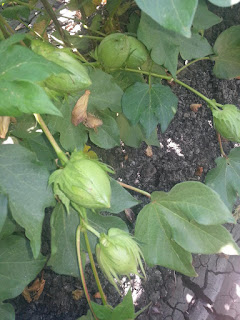It’s no secret cotton thrives in heat. That’s one reason you
see the fiber grown in the South, Southwest and, of course, California’s great
Valley.
“Cotton originated in hot, dry regions and prefers those conditions
to achieve maximum production,” says Australia’s Division of Agricultural
Services. “Cotton
therefore does best in areas with a long, hot season. The higher the average
temperature (within reason), the faster cotton will grow and develop.”
 Moreover, the growth of cotton plants will
follow a predictable pattern under favorable moisture and temperature
conditions. Growers can chart development by charting daily temperatures to
monitor the plant’s progress.
Moreover, the growth of cotton plants will
follow a predictable pattern under favorable moisture and temperature
conditions. Growers can chart development by charting daily temperatures to
monitor the plant’s progress.
For the Valley this summer, the average temperature
has beyond what the Aussie Ag folks would describe as “within reason.”
As mentioned in last week’s post, the Valley has experienced
a record-breaking July for consecutive 100-degree days in the region. While we
had a number of days in the high 90s this month, the average high for August so
far is 101 degrees, according to the National Weather Service.
 |
| Excessive heat could impact cotton bolls. |
“Cotton plants can grow three inches a day when it’s 100 degrees or more during the day,” field scout Damien Jelen says. “Growers have been treating their fields with plant growth regulators.”
Growers can experience production problems if their plants grow too much – which in industry parlance is called “excessive vegetative growth.” This condition can lead to delayed maturity, boll rot and problems during harvest. If the plants grow too tall, the open bolls would be out of the reach for the harvesters collect the fiber, Damien says. We’ll have to see how many more Hot August Days and Nights are in store the rest of this month.
 |
| Worm counts are up in alfalfa fields. |
Meanwhile on the pest front, Damien says aphid and worm counts are on the upswing while lygus numbers are under control. He says some alfalfa growers are treating their fields for worms.
In almonds, the harvest continues to be off to a slow start, according to field scout Jenna Mayfield. Activity has been less than robust for this time of the year. Jenna anticipates tree shaking to pick up this week.
Packers And Movers Bangalore Local Household Shifting Service, Get Free Best Price Quotes Local Packers and Movers in Bangalore List, Compare Charges, Save Money
ReplyDeleteAnd Time @ Packers And Movers Bangalore